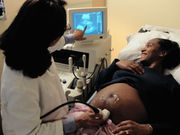Fetal crown-rump length, gestational age, and mother’s BMI affect accuracy
MONDAY, Dec. 21, 2015 (HealthDay News) — Ultrasound can be used to determine the sex of a fetus during the first trimester of pregnancy, according to a study published online Dec. 11 in the Journal of Clinical Ultrasound.
Sebastián Manzanares, M.D., from the Virgen de las Nieves University Hospital in Granada, Spain, and colleagues evaluated the feasibility and success rate of fetal sex determination on transabdominal sonographic examination at 11 to 13 weeks of gestation. Maternal, fetal, and operator factors possibly influencing the accuracy of the determination were also assessed.
The researchers found that fetal sex determination was feasible in 608 of the 672 fetuses (90.5 percent), and the prediction was correct in 532 of these cases (87.5 percent). Fetal sex was more accurately predicted as the fetal crown-rump length and gestational age increased, whereas accuracy was diminished as maternal body mass index increased. The best cut-off values for sex prediction were a fetal crown-rump length >55.7 mm, a gestational age of more than 12 weeks + 2 days, and a body mass index below 23.8 kg/m². The feasibility or accuracy of sex determination was not affected by maternal, fetal, or operator factors.
“The sex of a fetus can be accurately determined on sonographic examination in the first trimester of pregnancy,” the authors write.
Copyright © 2015 HealthDay. All rights reserved.








